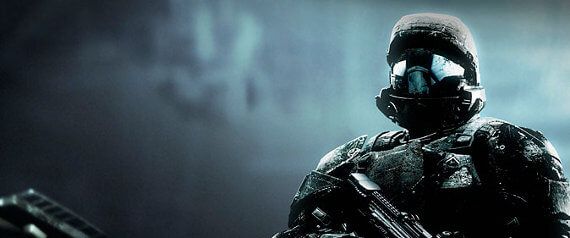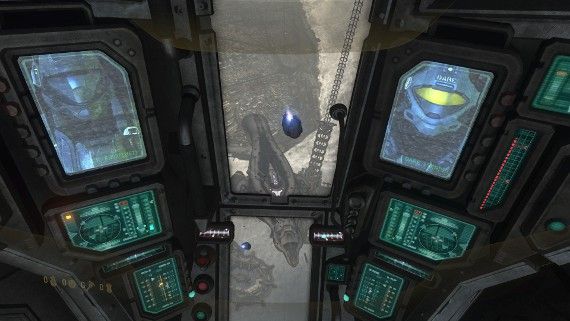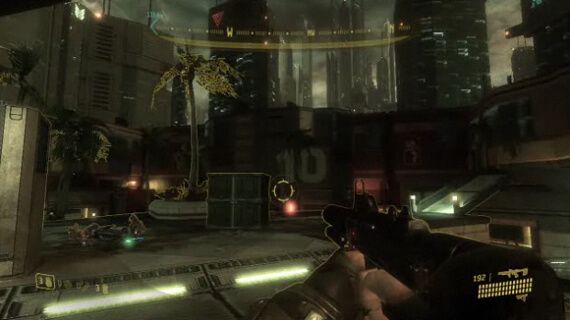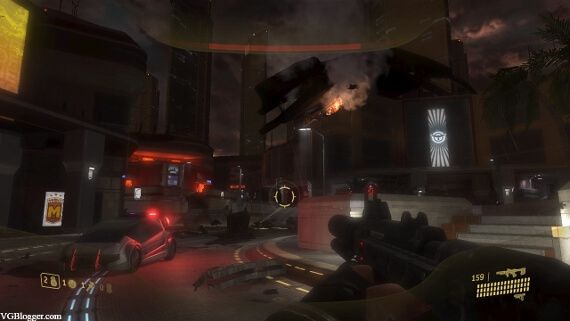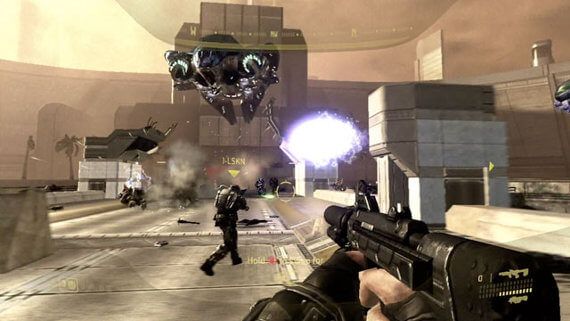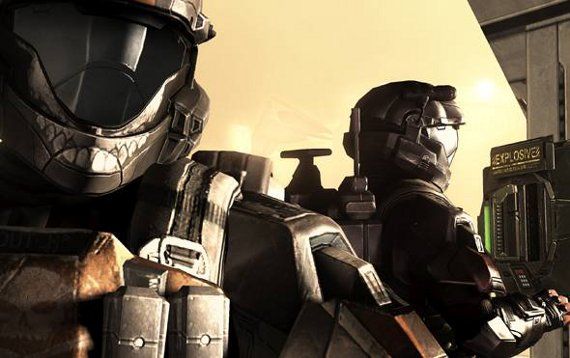Halo: Reach is right around the corner, and our collective anticipation has just about reached critical mass. It's a testament to the Halo franchise that, after four extremely similar predecessors and an RTS later, we still find ourselves completely drooling over it.
The most recent Halo-branded game, Halo 3: ODST was the most controversial title of the entire series, which is an odd thought when you consider that there was also an RTS in the mix. Halo 3: ODST thoroughly polarized gamers the world over; though, gaming journalists almost universally panned it, positioning it as Halo's only failure - the only time Bungie got it all wrong. Let's examine that a little, though, because upon closer scrutiny, ODST's legacy is more than a little unfair.
For starters, Halo 3: ODST was a beast with 3 backs. In the box was the expected single-player campaign and a new multiplayer-centric mode called Firefight. Then, inexplicably, there was a second disc, containing the standard multiplayer modes that came with Halo 3 two years earlier, but with the extra DLC already bundled-in. Why did the second disc even exist? Did either Bungie or Microsoft believe, for a second, that the people buying ODST didn't already own Halo 3? Of course not, but that's what happens when a company sells you a $30 game for $60.
We weren't fooled then and we aren't fooled now. Microsoft didn’t have any megaton 1st-Party Xbox 360-exclusive titles in their 4th-quarter holiday lineup and so they figured they'd lean on Bungie, their faithful, and at the time internal, cash-cow, for a shot of Christmas cheer. Bungie was able to stretch out the mini-mission-pack gambit they were working on, so that they could lord it over the Holiday season, as per usual. This, of course, did not stop any of us from buying it on launch day.
Halo 3: ODST was a game of dichotomy, of both the epic and the intimate, but it’s execution was exemplary, and it was in fact quite a good game.
Bungie took a huge gamble in the premise of ODST by taking the epic Halo space opera storyline, and pulling away from the sexy allure of the big green giant clinging to a spacecraft’s hull. The Spartan upon who’s shoulders the fate of humanity sat went on to finish the fight, as ever, but this go-around we didn't follow Master Chief. Instead, our focus left the stars and fell back down to a besieged Earth.
The ODST experience focused on a small team of weak, vulnerable grunts. Compared to Master Chief, these characters only played a small role in Mankind's galactic war against the Covenant.
Somewhere in a distant star system, Master Chief was driving a burning Warthog across the surface of a gargantuan alien weapon, accompanied by tribal drums and chanting monks but ODST had us cowering in a New Mombasa alleyway in the dead of night, slowly healing as an enemy patrol passed by, with no musical accompaniment save for occasional soft piano vignettes.
In several ways, this was very much a noir take on the Halo canon, and it was during these nighttime sections that this title was truly interesting and different.
During your squad’s shock drop onto a New Mombasa hot zone, something went awry and all your one-man drop pods got scattered across the land. After the crash, you awoke to find yourself lying in your twisted and beaten pod, perched atop a roof two stories above street level, at night. Covenant drop-ships cruised overhead, and small squads of Covenant ground troops patrolled the streets below. You were most definitely behind enemy lines, but so far unnoticed. Time to man-up, and find the rest of your squad via various in-game mechanics that would propel the story forward.
Thus began your lonely journey, through New Mombasa in the dead of night, actively avoiding the enemy when possible, and searching the landscape for health kits, ammo, and beacons on your map.
The beacon signals lead you to very specific items, such as a sniper rifle with a bent barrel, or an ODST helmet embedded in a piece of scenery. Reaching each of these items triggered a flashback sequence that put you in the shoes of one of your squad-mates at an earlier time that day, allowing you to play through their story for a period of time. At the end of these flashbacks, you returned to the viewpoint of the Rookie and continued your lonely midnight crawl through New Mombasa.
ODST was by no means a classic Halo game. Imagine ODST as Halo’s artsy, emo cousin, the one with the beard and a wardrobe full of black sweaters. I distinctly remember at the time explaining that the game had an Empire Strikes Back vibe about it, but not for any one reason that I can pinpoint. There is an almost cozy, late-evening flavor to Empire Strikes Back that lends it a sense of soul not present in the other films of the trilogy. ODST had that flavor.
The night time isolation, the whimpers of pain as your hero took damage, the blazing orange evening-scapes, and the brooding lounge-style piano and saxophone put this game on an entirely different shelf when compared to previous Halo games. Indeed, at times, the ambiance could almost confuse you into thinking you’re playing a romance-drama from the 1980s starring Jacqueline Bisset.
However, the flashback sections were like an adrenaline kick straight to your muscle-memory. The quiet brooding of midnight lounge piano gave way to those familiar thumping war drums and the sounds of combat. Nighttime gave way to blowing-stuff-up-time, throwing you into the action immediately.
At these points ODST transformed back into the Halo 3 of old, but in a somewhat muted fashion. Stepping into the shoes of a mortal ODST, your jumps covered less real estate than they did as a Spartan, melee attacks didn't do as much damage, and the enemy could easily drop you in a heartbeat - you pathetic human. Strangely enough, you could still rip gun turrets from their mounts as easily as Master Chief and could run around carrying them faster than he ever could.
It was during these moments Master Chief's absence was felt the most, and as a result, made me wonder why Bungie ever decided to go down this path in the first place. To give us so much in earlier games - namely, allowing us to assume the role of an eight foot tall, near-indestructible warrior - providing a similar experience, this time with a depreciated, less-able, protagonist, was a noodle-scratcher, to say the least. That Bungie was eager to tell this story (in this way) was a testament to their willingness to evolve as a studio and veer away from the path of guaranteed megabucks. I applauded them for that at the time, and I still do. Indeed, this game was a triumph in a hundred more ways than it was a failure.
With needle-like precision, Bungie wove the oldest story in video gaming - mankind locked in a desperate battle for survival against a more powerful alien oppressor - and they brought it together as something new and fresh, while still staying faithful to the old guard.
The single, most effective contribution from any of the disciplines called upon in the game’s development was undoubtedly the sound design and musical landscape created by Marty O’Donnell. As if to reflect the rest of the team’s deviation from previous Halo successes, he did the same, throwing out all traces of the musical themes we were familiar with, and instead designing an entirely new musical landscape that fit the game's vibe like a glove. For ODST, he brought to the table saxophones, single-note piano scores, techno and jazz - for the most part, instruments and musical styles as alien to the Halo franchise as you could imagine. The music came together beautifully and worked in the same magical way as his contribution to the other games - enhancing the experience tenfold.
Bungie possesses an incredible testicular fortitude - to even attempt creating ODST demands respect. However, to see them succeed wasn't entirely surprising. This is Bungie, after all. But for as expertly crafted as ODST's execution was, the gameplay let it down.
The single-player campaign, for all its deliberate differences, left most gamers wanting something more developed and varied. The fantastic core premise of playing an out-gunned clandestine soldier in occupied home-territory was compelling and more exciting than the act of playing it actually was. Bungie built a nighttime world suitable for stealth and sneakiness. They also made your character weak and vulnerable to enforce that style of play, forcing you to creep around and scavenge for ammo and health, assess the enemy, and attack in a measured fashion. Unfortunately, since no discernible changes were made to the enemy AI, every enemy encounter played out exactly as it would in any other Halo game, only without the convenience of a regenerating health bar or meaningful melee moves.
Because of this, the gameplay segments that took part during the day - the flashback moments - were a welcome respite from the unpleasant survivalist machinations of the nighttime sections, but they were vignettes only. More often than not, the daytime levels lasted only for a fraction of the time it took to play an entire nighttime section. Additionally, all the spectacular set-piece moments happened during the daytime sections of the game. The nighttime sections were bereft of any interesting happenings at all. Just wandering through the streets and intervals of combat. Why have the primary story arc of the game be the least enjoyable part of it?
That isn't to say that all we wanted from ODST was another few levels of familiar Halo-branded action. Not at all. If anything I wanted a Halo-quality game that would be executed with a fresh perspective.
The nighttime sections housed some ingenious mechanics that fell flat due to poor execution only. The AI of New Mombasa, known only as The Superintendent, was the single, most under-utilized aspect of the entire game. It was at all times present in the heart of the city, controlling all the signs, roads, locks and lights in the New Mombasa, and it was on your side. It lit directional signs to point you to health, and raised barriers to block your progress when you approached too close to an unforeseen enemy group. The Superintendent could have been utilized in so many ways, and ultimately it served only to help us with finding poorly-voiced audio logs of New Mombasa's inhabitants as they described the invasion. Why not add programmable turrets? Why no programmable street geography that you could manipulate via hacked interfaces to separate and trap individual enemies from their groups, while observing your efforts via security cameras?
Ultimately, ODST was different and unique, but only when compared to other Halo games. It had more soul than the other Halo titles, to be sure, but in the end it fell short of reaching the level we expect from Bungie.
It'd difficult not to hold ODST to the same standard as other Halo games, it was still branded as a Halo title, and with good reason: without the Halo branding, ODST was not a very good deal at all. It was a polished experience, to be sure, but the arc wasn't complete. When you strip away the extra disc in the box and the admittedly great, but flawed Firefight mode, ODST was an entree (with no appetizer or dessert), and was awash with missed opportunities. It was merely a blast of implied greatness, when the price tag implied a more prolonged and complete experience.
For all its faults and shortcomings, ODST still sold extraordinarily well, of course, calling it a failure for any reason (other than for not meeting our expectations) would be unfair. Rather than being Bungie's worst hour, it was their most promising, yet unrealized reinvention of the Halo franchise.
At the very least, Halo: Reach will do what ODST could not. It will deviate from Bungie's conventional Halo releases of the past, as ODST did, only this time provide Halo fans a truly complete Halo experience in which Master Chief is nowhere to be found.
Roll out with Halo: Reach on September 14th, 2010.

